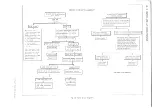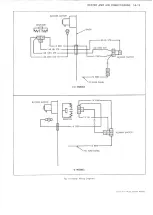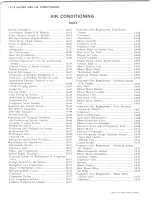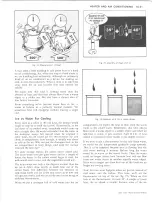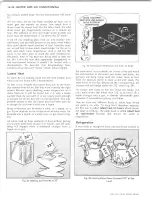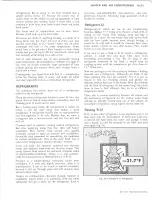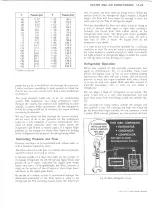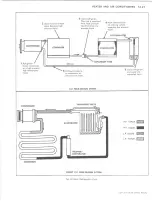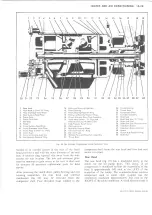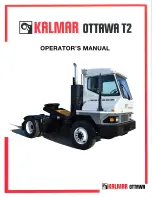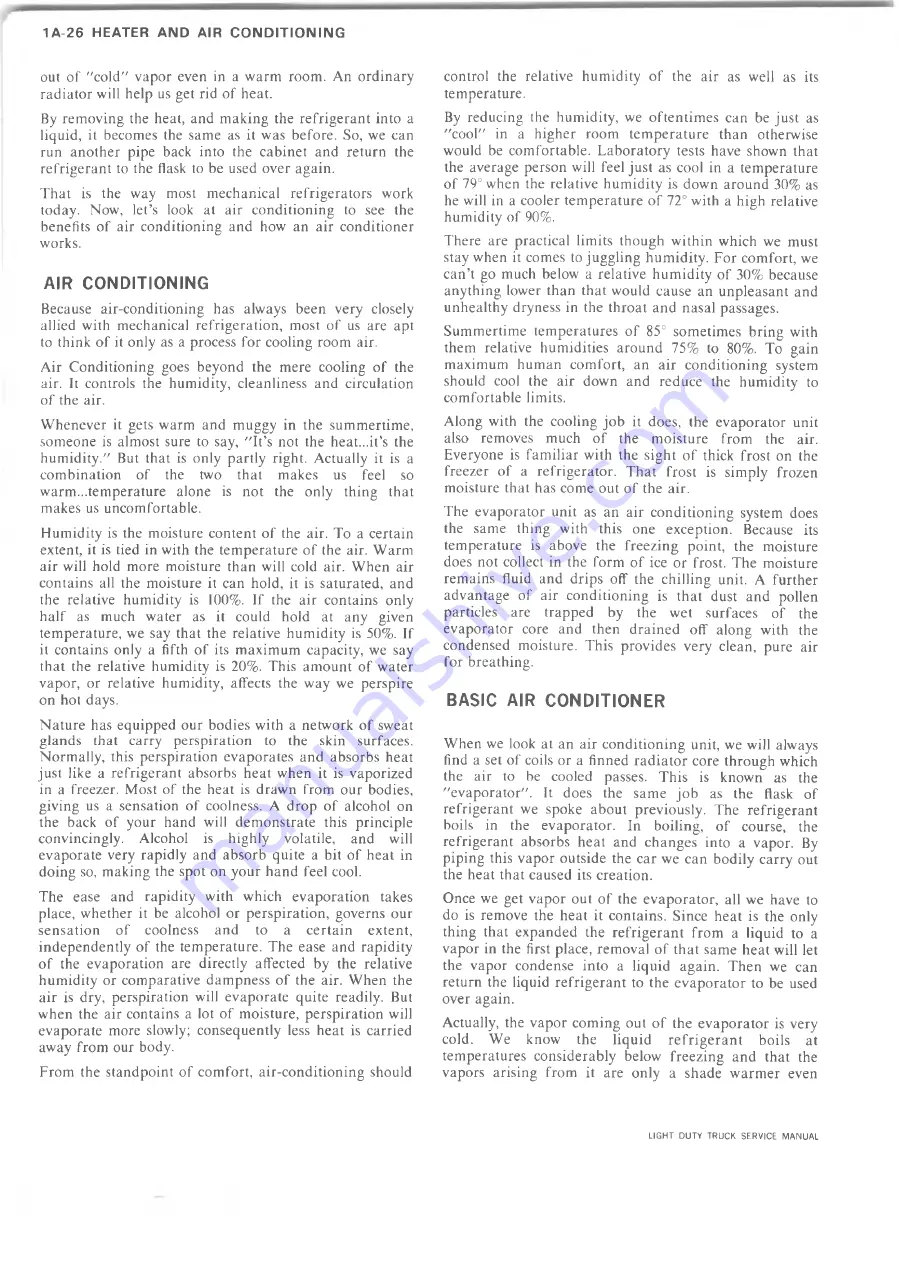
1A-26 HEATER A N D AIR C O N D I T I O N I N G
out of "cold" vapor even in a warm room. An ordinary
radiator will help us get rid of heat.
By removing the heat, and making the refrigerant into a
liquid, it becomes the same as it was before. So, we can
run another pipe back into the cabinet and return the
refrigerant to the flask to be used over again.
That is the way most mechanical refrigerators work
today. Now, let’s look at air conditioning to see the
benefits of air conditioning and how an air conditioner
works.
AIR CONDITIONING
Because air-conditioning has always been very closely
allied with mechanical refrigeration, most of us are apt
to think of it only as a process for cooling room air.
Air Conditioning goes beyond the mere cooling of the
air. It controls the humidity, cleanliness and circulation
of the air.
Whenever it gets warm and muggy in the summertime,
someone is almost sure to say, "It’s not the heat...it’s the
humidity." But that is only partly right. Actually it is a
combination of the two that makes us feel so
warm...temperature alone is not the only thing that
makes us uncomfortable.
Humidity is the moisture content of the air. To a certain
extent, it is tied in with the temperature of the air. Warm
air will hold more moisture than will cold air. When air
contains all the moisture it can hold, it is saturated, and
the relative humidity is 100%. If the air contains only
half as much water as it could hold at any given
temperature, we say that the relative humidity is 50%. If
it contains only a fifth of its maximum capacity, we say
that the relative humidity is 20%. This amount of water
vapor, or relative humidity, affects the way we perspire
on hot days.
Nature has equipped our bodies with a network of sweat
glands that carry perspiration to the skin surfaces.
Normally, this perspiration evaporates and absorbs heat
just like a refrigerant absorbs heat when it is vaporized
in a freezer. Most of the heat is drawn from our bodies,
giving us a sensation of coolness. A drop of alcohol on
the back of your hand will demonstrate this principle
convincingly. Alcohol is highly volatile, and will
evaporate very rapidly and absorb quite a bit of heat in
doing so, making the spot on your hand feel cool.
The ease and rapidity with which evaporation takes
place, whether it be alcohol or perspiration, governs our
sensation of coolness and to a certain extent,
independently of the temperature. The ease and rapidity
of the evaporation are directly affected by the relative
humidity or comparative dampness of the air. When the
air is dry, perspiration will evaporate quite readily. But
when the air contains a lot of moisture, perspiration will
evaporate more slowly; consequently less heat is carried
away from our body.
From the standpoint of comfort, air-conditioning should
control the relative humidity of the air as well as its
temperature.
By reducing the humidity, we oftentimes can be just as
"cool" in a higher room temperature than otherwise
would be comfortable. Laboratory tests have shown that
the average person will feel just as cool in a temperature
of 79° when the relative humidity is down around 30% as
he will in a cooler temperature of 72° with a high relative
humidity of 90%.
There are practical limits though within which we must
stay when it comes to juggling humidity. For comfort, we
can’t go much below a relative humidity of 30% because
anything lower than that would cause an unpleasant and
unhealthy dryness in the throat and nasal passages.
Summertime temperatures of 85° sometimes bring with
them relative humidities around 75% to 80%. To gain
maximum human comfort, an air conditioning system
should cool the air down and reduce the humidity to
comfortable limits.
Along with the cooling job it does, the evaporator unit
also removes much of the moisture from the air.
Everyone is familiar with the sight of thick frost on the
freezer of a refrigerator. That frost is simply frozen
moisture that has come out of the air.
The evaporator unit as an air conditioning system does
the same thing with this one exception. Because its
temperature is above the freezing point, the moisture
does not collect in the form of ice or frost. The moisture
remains fluid and drips off the chilling unit. A further
advantage of air conditioning is that dust and pollen
particles are trapped by the wet surfaces of the
evaporator core and then drained off along with the
condensed moisture. This provides very clean, pure air
for breathing.
BASIC AIR CONDITIONER
When we look at an air conditioning unit, we will always
find a set of coils or a finned radiator core through which
the air to be cooled passes. This is known as the
"evaporator". It does the same job as the flask of
refrigerant we spoke about previously. The refrigerant
boils in the evaporator. In boiling, of course, the
refrigerant absorbs heat and changes into a vapor. By
piping this vapor outside the car we can bodily carry out
the heat that caused its creation.
Once we get vapor out of the evaporator, all we have to
do is remove the heat it contains. Since heat is the only
thing that expanded the refrigerant from a liquid to a
vapor in the first place, removal of that same heat will let
the vapor condense into a liquid again. Then we can
return the liquid refrigerant to the evaporator to be used
over again.
Actually, the vapor coming out of the evaporator is very
cold. We know the liquid refrigerant boils at
temperatures considerably below freezing and that the
vapors arising from it are only a shade warmer even
LIGHT DUTY TRUCK SERVICE MANUAL
Summary of Contents for Light Duty Truck 1973
Page 1: ......
Page 4: ......
Page 6: ......
Page 53: ...HEATER AND AIR CONDITIONING 1A 27 LIGHT DUTY TRUCK SERVICE MANUAL...
Page 115: ...LIGHT DUTY TRUCK SERVICE M A N U A L HEATER AND AIR CONDITIONING 1A 89...
Page 123: ...BODY 1B 3 Fig 6 Typical 06 Van LIGHT DUTY TRUCK SERVICE MANUAL...
Page 149: ...BODY 1B 29 Fig 84 Body Mounting 06 Fig 85 Body Mounting 14 LIGHT DUTY TRUCK SERVICE MANUAL...
Page 171: ...LIGHT DUTY TRUCK SERVICE M A N U A L Fig 2 Frame Horizontal Checking Typical FRAME 2 3...
Page 173: ...LIGHT DUTY TRUCK SERVICE M A N U A L Fig 4 10 30 Series Truck Frame FRAME 2 5...
Page 174: ...2 6 FRAME LIGHT DUTY TRUCK SERVICE MANUAL Fig 5 Underbody Reference Points G Van...
Page 185: ...FRONT SUSPENSION 3 11 Fig 16 Toe out on Turns LIGHT DUTY TRUCK SERVICE MANUAL...
Page 224: ......
Page 266: ......
Page 351: ...ENGINE 6 15 Fig ID Sectional View of Eight Cylinder Engine LIGHT DUTY TRUCK SERVICE MANUAL...
Page 375: ...EN G IN E 6 39 LIGHT DUTY TRUCK SERVICE MANUAL...
Page 376: ...6 4 0 ENGINE LIGHT DUTY TRUCK SERVICE MANUAL...
Page 377: ...ENG IN E 6 41 LIGHT DUTY TRUCK SERVICE MANUAL...
Page 378: ...LIGHT DUTY TRUCK SERVICE MANUAL Fig 37L K Series Engine Front Mount 6 42 ENG INE...
Page 400: ...6 6 4 ENG INE LIGHT DUTY TRUCK SERVICE MANUAL...
Page 401: ...ENG IN E 6 65 LIGHT DUTY TRUCK SERVICE MANUAL...
Page 402: ...6 6 6 ENGINE LIGHT DUTY TRUCK SERVICE MANUAL...
Page 403: ...E NG IN E 6 67 Fig 36V C Series Engine Mounts LIGHT DUTY TRUCK SERVICE MANUAL...
Page 410: ......
Page 423: ...EN G IN E C OOLING 6K 13 Fig 16 Overheating Chart LIGHT DUTY TRUCK SERVICE MANUAL...
Page 424: ...6 K 1 4 ENG INE COOLING Fig 17 Coolant Loss Chart LIGHT DUTY TRUCK SERVICE MANUAL...
Page 456: ...6M 32 ENGINE FUEL Fig K15 Accelerator Controls G Van L 6 LIGHT DUTY TRUCK SERVICE MANUAL...
Page 492: ......
Page 512: ...Fig 18e Vacuum Advance Diagram V8 Engine...
Page 516: ...6 T 2 4 E M IS S IO N CONTROL SYSTEMS LIGHT DUTY TRUCK SERVICE MANUAL...
Page 528: ......
Page 590: ......
Page 593: ...CLUTCHES MANUAL TRANSMISSIONS 7M 3 LIGHT DUTY TRUCK SERVICE MANUAL...
Page 598: ...7M 8 CLUTCHES MANUAL TRANSMISSIONS LIGHT DUTY TRUCK SERVICE MANUAL...
Page 642: ......
Page 654: ......
Page 743: ...FUEL TANKS AND EXHAUST 8 13 LIGHT DUTY TRUCK SERVICE MANUAL...
Page 744: ...8 14 FUEL TANKS AND EXHAUST LIGHT DUTY TRUCK SERVICE MANUAL...
Page 760: ...8 30 FUEL TANKS AND EXHAUST Fig 40 Exhaust Pipe P Models LIGHT DUTY TRUCK SERVICE MANUAL...
Page 761: ...FUEL TANKS AND EXHAUST 8 31 LIGHT DUTY TRUCK SERVICE MANUAL...
Page 763: ...FUEL TANKS AND EXHAUST 8 33 LIGHT DUTY TRUCK SERVICE MANUAL...
Page 766: ......
Page 832: ...LIGHT DUTY TRUCK SERVICE MANUAL Fig 106 Power Steering Pump Mounting Typical 9 66 STEERING...
Page 833: ...PUMP ASSEMBLY STEERING GEAR TYPICAL SMALL V8 TYPICAL LARGE V8 STEERING 9 67...
Page 861: ...STEERING 9 95 Fig 134 Power Steering Pump Leakage LIGHT DUTY TRUCK SERVICE MANUAL...
Page 864: ......
Page 876: ......
Page 886: ...11 10 CHASSIS SHEET METAL LIGHT DUTY TRUCK SERVICE MANUAL...
Page 891: ...ELECTRICAL BODY AND CHASSIS 12 5 LIGHT DUTY TRUCK SERVICE MANUAL...
Page 934: ......
Page 942: ......
Page 970: ......
Page 972: ......
Page 974: ......
Page 976: ...V...
Page 978: ......
Page 979: ......

